We show that hydrogel particles could be easily synthesized by adding drops of aqueous solution containing monomer, comonomer, crosslinker, and initiator to the surface of a polytetrafluoroethylene (PTFE or Teflon) disk immersed in 2,2,4-trimethylpentane (TMP). This system yielded conditions that allowed for a spherical drop to be stable at that interface while the polymerization occurred. This approach was used to synthesize particles composed of poly(N-isopropylacrylamide) (pNIPAm) and poly(2-hydroxyethyl methacrylate) (pHEMA). Furthermore, the polymer particles could easily be doped with a variety of nanoparticles and small molecules simply by adding the components to the monomer/crosslinker solution prior to polymerization. This synthetic route is advantageous because it only appears to depend on the ability to form a water drop at the PTFE–TMP interface, thus this approach can be used to synthesize particles with a variety of different functionalities and compositions. This can lead to direct applications in oral drug delivery and tissue engineering.
